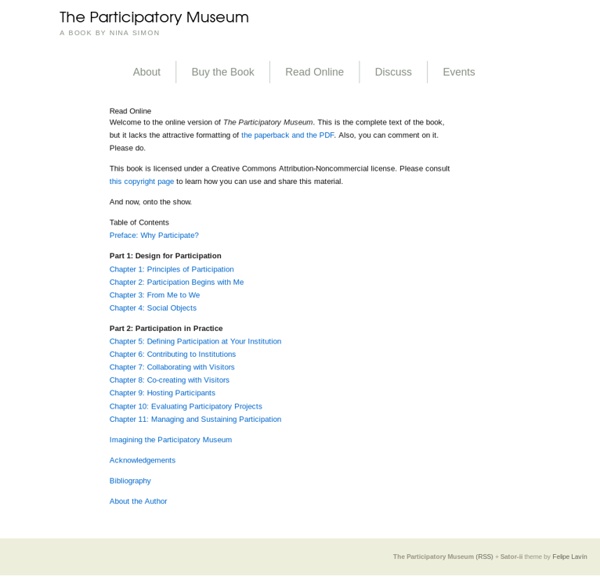Museum 2.0
Randers Regnskov: Zoologisk have
Enlaces entre accesibilidad y participación. Múltiples voces en el Museo de Diseño de Helsinki.
1. Introducción: el caso de estudio La vida secreta de los objetos, un mapa interactivo del diseño finlandés (1) fue una exposición temporal (18 de Marzo al 1ro de Junio de 2008) en el Museo de Diseño de Helsinki, Finlandia, que recopiló una selección de objetos de diseño, que pertenecen a la colección permanente. Con esta exposición buscamos reinterpretar los objetos a través de la participación activa de los visitantes del museo, fomentada por una serie de recursos diseñados para tal fin. 2. Las estrategias que se usaron para lograr una activa participación y apropiación de la exhibición fueron de diferente índole. 2.1 ACENTUADA PRESENCIA EN LA EXPOSICIÓN. 2.2 USO DE RECURSOS EN LA EXPOSICIÓN Y REMOTOS. 2.3 INTEGRACIÓN CON LAS PRÁCTICAS DEL MUSEO. 2.4 COLABORACIÓN ENTRE MUTIPLES VOCES Y MODOS DE EXPRESIÓN. 2.5 INCLUSIÓN DE MINORIAS LINGUISTICAS. 2.6 USO DE VOCABULARIO CASUAL. 2.7. 2.8 USO DE NUEVAS TECNOLOGÍAS BASADAS EN VIEJOS HÁBITOS. 3. Conclusiones Agradecimientos
Insumissia - Cómo realizar una Acción Directa Noviolenta y no ...
Os presentamos la guía teórico-práctica "Cómo realizar una Acción Directa Noviolenta y no sucumbir en el intento", elaborada por el Grupo Antimilitarista de Carabanchel y la Asamblea Antimilitarista de Madrid como apoyo a los talleres de Acción Directa Noviolenta (ADN) que impartimos. Además, también encontraréis una unidad didáctica para impartir dicho taller. Esperemos que sea de utilidad a todas las personas y grupos que quieren que la noviolencia y la ADN forme parte de su acción transformadora. Si tienes este texto en tus manos, lo más probable es que hayas –o hayáis– decidido tomar parte en una Acción Directa Noviolenta (ADN). Al realizar una ADN debes tener en cuenta que estás realizando un acto de desobediencia civil. Este texto es una guía de ayuda para realizar una ADN. La Asamblea Antimilitarista de Madrid aúna a activistas que, procedentes del MOC y de otras luchas, trabajan el antimilitarismo desde hace años. Asamblea Antimilitarista de Madrid Guía completa: Unidad didáctica:
De la cultura visual a la cultura hipertextual: La imagen digital y el nuevo paradigma artístico, tecnológico y científico
Contenido de la comunicación “Las obras ya no serán sino diversos tipos de fuente u origen, y se encontrarán o reencontrarán íntegros sus beneficios en donde se desee. De igual forma como el agua, el gas o la corriente eléctrica vienen de lejos a nuestras casas para atender nuestras necesidades con un esfuerzo casi nulo, así nos alimentamos de imágenes visuales o auditivas que nacerán y se desvanecerán al menor gesto, casi un signo. De igual forma como estamos acostumbrados, si no ya sometidos, a recibir energía en nuestra casa de diversas formas, así nos será muy sencillo obtener o recibir también esas variaciones u oscilaciones rapidísimas, con las que nuestros órganos sensoriales, que las recogen e integran, hacen todo lo que sabemos. No sé si filósofo alguno ha soñado jamás con una sociedad para la distribución de la Realidad Sensible a domicilio.” Mario Markus. La cultura de la imagen y la cultura del texto El verbo griego graphein significaba tanto escribir como dibujar.
Museos 2.0: Las redes sociales como enlace directo entre los museos y su público
Resumen Comunicación informal y directa con el público, así como publicidad económica o casi gratuita, son las ventajas que ofrece el uso de redes sociales como Twitter y Facebook a los museos alrededor del mundo. A través de estas herramientas de la Web 2.0, las instituciones culturales establecen una relación horizontal con su audiencia, al lograr una comunicación sin intermediarios. En Twitter, servicio de "microblogging" nacido en 2006, existen al menos 623 museos que informan en tiempo real sobre lo que está sucediendo en el interior de sus muros: publican imágenes del montaje de sus exposiciones o cuando son visitados por una celebridad, notifican sobre eventos próximos, reportan sobre conferencias o espectáculos que ocurren en el momento, y ofrecen datos curiosos sobre sus colecciones. Estos recintos tienen en conjunto, hasta ahora, a más de 719 mil seguidores a través de esta red social. Bibliografía/Referencias “ ”, indica Samra. “ ”, comenta [2] . “ ”, señala Boulton. “ ”, dice.
Goteo, economía distribuida en el sector de la innovación cultural
Las redes sociales en Internet han propiciado la aparición de nuevas vías de financiación de proyectos donde se eliminan los intermediarios o se reduce su papel. La iniciativa Goteo de Platoniq propone trasladar este modelo al ámbito de la creación cultural, conectando ideas con el público cultural, las instituciones y las empresas. El próximo 14 de diciembre se presenta en un taller sobre economía distribuida en Barcelona. A través de la Web 2.0 han surgido propuestas vinculadas a una economía alternativa, gracias a su potencial para conectar a las personas a través de redes de forma horizontal y sin la necesidad de intermediarios. El proyecto Goteo del colectivo Platoniq propone trasladar este modelo de Giving 2.0 y la fórmula de intercambio peer-to-peer al ámbito de la creación cultural emergente. El próximo 14 de diciembre Goteo se presenta en el Centre de Cultura Contemporània de Barcelona, dentro de una jornada sobre economía distribuida. También puede interesarte:



